Nutritional Interventions to Manage Heat Stress in Cattle
- Healthy life
Dr. Mahesh G R, Technical Manager, Trouw Nutrition India
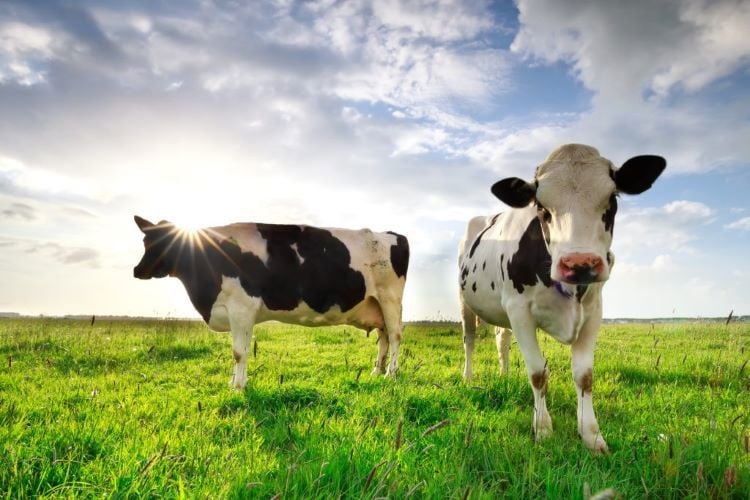
Dairy cows are exposed to several stress factors of which heat stress is a major recurring factor that is to be addressed effectively to avoid negative impact on growth and performance of animals and hence the overall farm profitability. Ruminants are more susceptible to heat stress when compared to monogastric animals due to their method of fermentative digestion as it generates more heat compared to enzymatic digestion. Heat stress is defined as a state where the core temperature of a given animal exceeds its normal range due to excess environmental heat load combined with less heat dissipation capability. Relative humidity (RH) along with temperature plays a critical role in determining the actual heat felt by the animals, hence the temperature humidity index (THI), is a better indicator of heat stress, rather than the individual components. At high RH of 75% and above and at temperatures of 900F or above, a dramatic decrease in milk production ranging from 3 to 20% can be noticed. As was witnessed in 2020, with the drop of 0.73 million litres in milk production (Upadhyay et al., 2007). These negative impacts of heat stress can be reduced through interventions in nutrition, management and genetics. This can include practices like keeping the farm environment cool, nutrient modulations, selective breeding for heat tolerant animals etc.
- Effects of heat stress
High temperatures and humidity are harmful to the productivity of dairy cows. Heat stress affects feed intake, body temperature, maintenance requirements and metabolic processes, feed efficiency, milk yield, reproductive efficiency, behavior and resistance to infection (Fig. 1).
Fig. 1: Impact of heat stress on animal performance
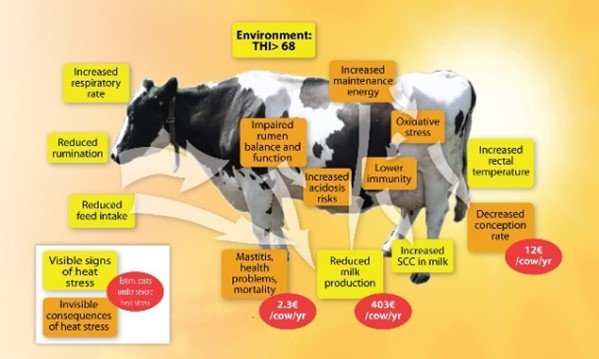
Heat stress of a dairy animal is measured in terms of THI to denote thermal comfort of animals (Fig. 2).
Fig. 2: THI Index – Heat stress indicator
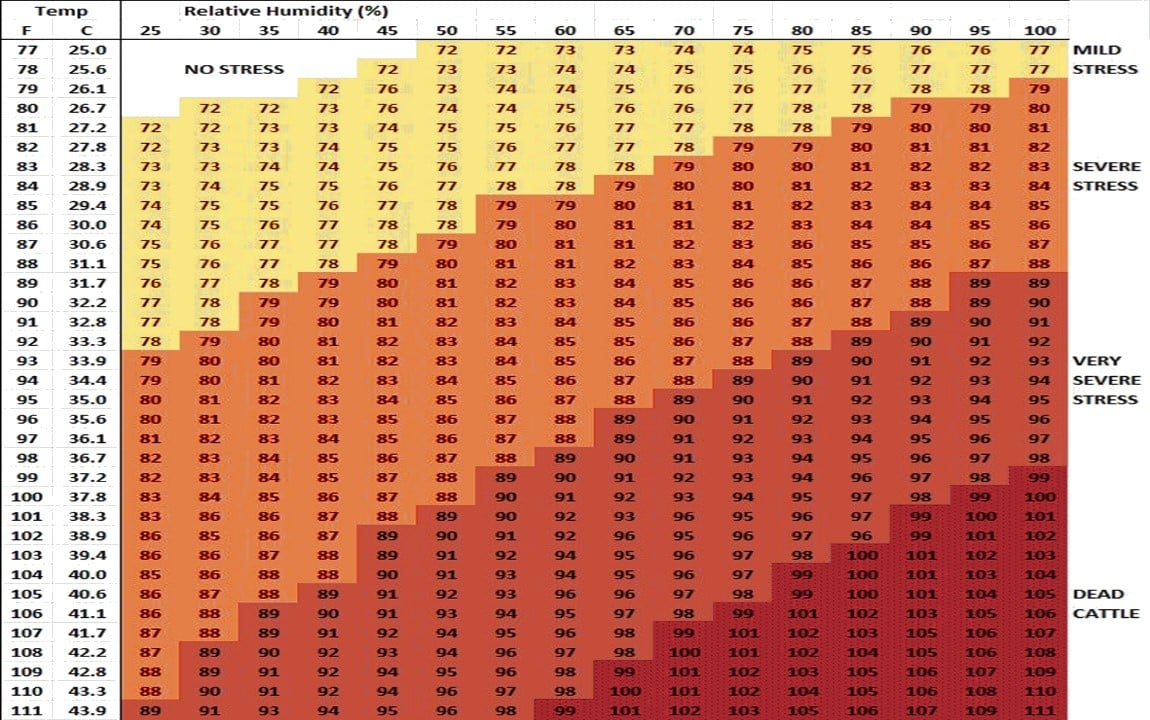
The ideal THI for dairy cows should be less than 68 (Table-1).
Table 1: THI as an indicator of heat stress
|
Heat stress level |
THI |
Respiration (breaths per minute) |
Body temperature (0 F) |
|
No heat stress |
Less than 68 |
40-60 |
101.5-102.5 |
|
Mild |
68-71 |
60-75 |
102.5-103 |
|
Mild to moderate |
72-79 |
75-85 |
103-104 |
|
Moderate to severe |
80-90 |
85-100 |
104-105 |
|
Severe |
90-99 |
100-104 |
Over 105 |
Heat stressed ruminants takes less feed, to cut back heat generated during the process of digestion. Reduced dry matter intake (DMI) in turn leads to less mastication and therefore less salivation which leads to a low ruminal pH. High yielding animals need highly concentrated diets to maintain milk yield which makes them more prone to ruminal acidosis. Heat stress will influence the various components of milk such as fat, solid-non-fat (SNF), protein, casein, and milk sugar content. During heat stress, animal increases its respiration rate to dissipate heat, this contributes to a decrease in CO2 blood concentration that induces an increased secretion of bicarbonate (HCO3-) by kidney and less HCO3- provided by saliva. Fat mobilization and its utilization as an energy source is suppressed, throughout heat stress. Therefore, impacted cows rely mainly on glucose as an energy source for maintenance and milk production. Heat-stressed cows have been reported to increase their standing time (Allen et al., 2015), and in turn less activity, to expose more surface area for heat loss, hence leading to lameness. Conception rates decreases by 20-30% in summer mainly due to altered estrus expression and oocyte loss. Exposure to high ambient temperature may also result in significant alterations and damages at the cellular level. So, increasing the availability of glucose to dairy cows should be the primary aim to eliminate production losses. It should be supplemented with the electrolytes, rumen stabilizers, antioxidants, vitamins, minerals, and immune modulators to combat heat stress.
- Common signs and strategies to reduce heat stress
Common signs (Fig. 3) exhibited by heat stressed animals are moving to shade, increased water intake with reduction in DMI intake, prefers standing than lying down, increased respiration rate, body temperature, increased drooling of saliva, open-mouth panting, disturbances in production and reproduction etc.
Fig. 3: Common signs during heat stress
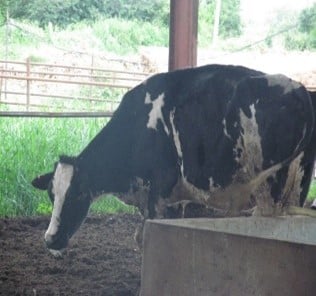
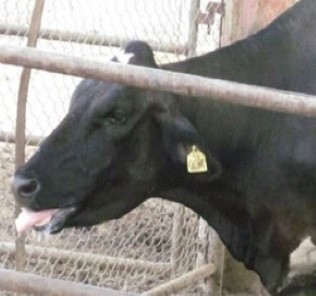
Various practices to reduce the ill-impacts of heat stress which can be adopted are providing good potable water throughout the day along with fans or sprinklers inside the farm (Fig. 4) and providing greater space and shade around the farm would help in lowering the heat load on animals.
Fig. 4: Sprinklers in dairy farm
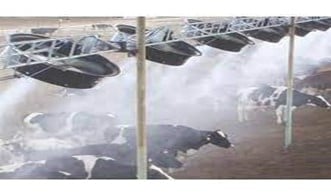
Breeding management like selection of animals based on specific molecular genetic markers for heat tolerance will be a boon to manage heat stress in cattle but it is long-term process.
So, in these circumstances, nutritional solutions are feasible, manageable and applicable at farm level. In this, low quality fodder needs to be replaced with high-quality ones, as latter is digested better and thereby results in less heat production. Decreased DMI reduces availability of nutrients to animals, which can be minimized by using concentrated feeds. However, diets should be balanced carefully to avoid digestive disorders such as acidosis and displaced abomasum. Other nutritional management tips to manage heat stress are providing high quality green fodders, increasing the frequency of feedings, feeding during cooler times of the day, keeping the feed as much fresh as possible, providing adequate fiber, including by-pass protein etc. Usage of apt feed additives and inclusion of additives like osmolytes, rumen modifiers, yeast supplements, vitamins, and trace minerals in an optimal way to fight heat stress effects.
Rumen modifiers & Yeast supplements in heat stress:
Moallem (2009), Marden (2008) and Salvati (2015) reported that supplementation of live yeast and sodium bicarbonate significantly improved the DMI and milk yield in dairy cows by reducing the impact of acidosis by stabilizing the rumen pH thereby decreasing the rumen redox potential and increasing the availability of glucose in blood plasma during heat stress conditions. Huang and coworkers (2017) also reported that action of sodium bicarbonate was only to buffer excess acid in the rumen whereas live yeast prevents the accumulation of lactate by increasing the microbial population of lactate utilizing bacteria and allowed better fiber digestion by increasing the fiber digesting bacteria thereby strengthening the ruminal environment. It is well known that β-glucans and mannooligosaccharides of yeast cell wall components modulate the immune response by activating macrophages, and release of pro-inflammatory cytokines and chemokines (TNFα, IL6) (Walachowski et al. 2016).
Osmolytes in heat stress:
Cows which received 15 g of osmolyte supplementation per day showed more Volatile fatty acids (VFAs) - acetate, and propionate concentrations which led to increased DMI and milk yield, when compared to control in heat stress conditions (Shaw et al., 2020). Betaine supplementation increases rumen fermentation by serving as a source of available nitrogen or methyl groups in the rumen. Studies show that betaine is metabolized in rumen and converted into acetate, which plays an essential role in fat synthesis. Betaine, as a zwitterion (dipolar ion), has a net neutral charge, but has a region of positive and negative charges which allows betaine to hold water molecules against a concentration gradient in ruminants, allowing it to act as an excellent osmolyte. In addition, betaine has a positive impact on the antioxidant status of animals by improving the levels of glutathione peroxidase and superoxide dismutase (SOD). These results suggest that betaine has the capacity to release heat stress in animals by reducing metabolic heat production and maintaining osmotic balance. That said, the form of betaine been supplemented plays a pivotal role, in its aforesaid mechanisms of action, with the betaine from natural source been a better and reliable form than synthetic ones.
Vitamin & Trace Mineral Nutrition in heat stress:
Reduced feed intake during heat stress decreases vitamins and minerals intake, which leads to decreased serum and liver concentrations of these micro-nutrients. Moreover, mobilization of minerals and vitamins from tissues and their excretion are increased under stress conditions due to increased respiration and perspiration. Zinc plays a critical role in antioxidant defense as an integral part of the essential enzymes SOD and prevents oxidative DNA damage. A significant rise in milk protein, fat, and lactose levels by 1.04, 1.06, 1.02 %, respectively is recorded when heat stressed dairy cattle are supplied with Chromium. Selenium has significant impact on glutathione peroxidase and Se concentrations, which is one of the mechanisms to protect dairy animals against heat stress.
Vitamin A supplementation in the peripartum period improves the reproductive performance and reduces the somatic cell count of heat stressed dairy animals. Niacin is involved in heat dissipation through the skin and possibly elevation of cellular heat shock proteins. Vitamin E is an antioxidant that plays important role in the maintenance of cellular membranes, immunity, and reproduction. Greater oxidative stress caused by elevated temperature and humidity creates a need for additional vitamin E as antioxidant in the summer. Vitamin E is involved in stimulation of serum antibody immunoglobulins synthesis (Tengerdy, 1980).
Balanced Micro-ingredients – Maxcare AHS
Nutritional approach with correct proportion reduces negative impact on milk production and reproduction. In line with this, Maxcare AHS (Anti Heat Stress) is designed as a comprehensive technical solution for managing boosting performance during heat stress conditions, through inclusion of tried, tested, and authenticated feed additive solutions. Maxcare AHS constitutes high quality osmolytes, rumen modifiers to optimize rumen pH, proven antioxidants, and minerals, which help in improving productivity, immunity, and fertility of dairy animals. These micro-ingredients are required in right concentrations or it could lead to inconsistent performance in animals. In this scenario, provision of an optimal combination of required micro-ingredients in a single convenient homogenous pack, as in Maxcare AHS, would resolve the above-mentioned challenges, with assured quality and performance enhancement.
- Conclusion
Heat stress brings about major physiological and behavioral changes in dairy cows, which negatively affects feed intake, feed efficiency, milk quality and quantity, reproductive efficiency, and disease incidences. These adverse effects can be reduced by following integrated strategies like farm management, nutritional management, breeding management etc. Amongst these, nutritional management plays a central role in reducing heat stress by usage of specific feed additives in optimal proportion. The use of combined feed additive package is a convenient and feasible way out to decrease heat stress in animals, with concomitant increase in the production of dairy cows. Maxcare AHS is a unique differentiated concept with all required feed additives in apt concentrations that has shown positive results in terms of reducing heat stress and improving productivity of cattle.
For further information, kindly write to us at customercareindia@trouwnutrition.com or visit our website: www.trouwnutrition.in